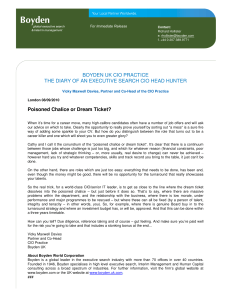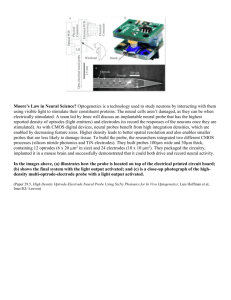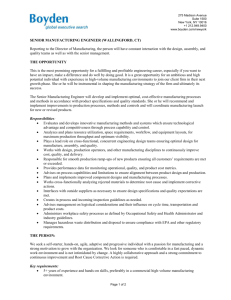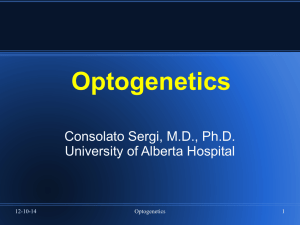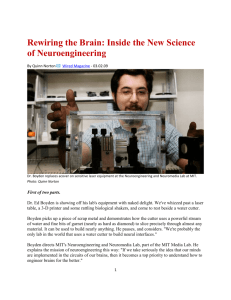Optogenetics
advertisement
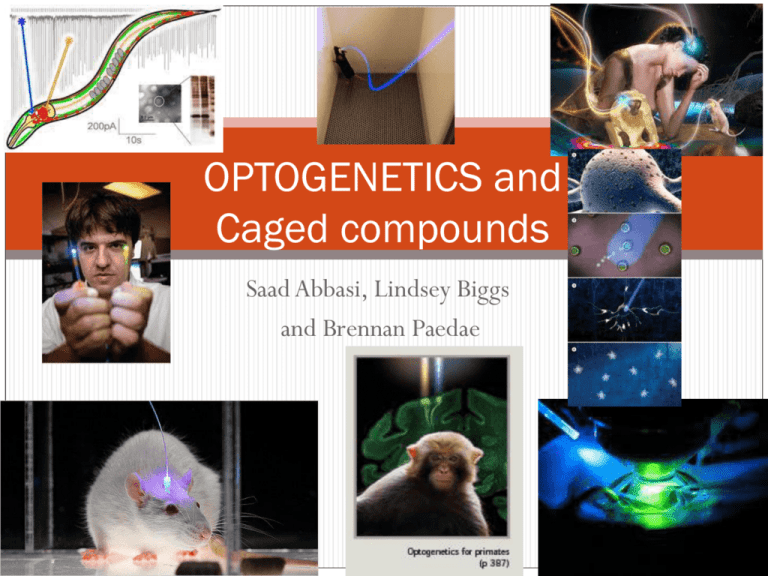
OPTOGENETICS and Caged compounds Saad Abbasi, Lindsey Biggs and Brennan Paedae History of the development of optogenetics Three-gene phototransduc tion cascade used to activate cells Discovery and study of opsins 1970’s Collaboration between Nagel, and Deisseroth (and Boyden) Halorhodopsin used for neural silencing Paper published by Chow et al, (2010) using archaerhodops in which completely shuts down the cell. 1999 Halorhodopsin and neural chloride levels Photo: Halobacterium salinarum http://www.biochem.mpg.de/en/eg/oester helt/web_page_list/Org_Hasal/index.html Paper on channelrhodo psin published by Georg Nagel et al. (2003) First published paper using optogenetics (Boyden et al., 2005) on cultured hippocampal neurons, followed by papers from several other labs Papers published using OptoXR, light activated GPCR’s which modulate intracellular signalling (Aiden,2009) and use in live primates (Han et al. 2009) Use of nanoparticles and magnetic pulses to activate specific cell types without such invasive measures (Palle Lab?) 1970-1980’s Discovery and study of opsins Halobacterium salinarum: Motile organisms Can live with light as the only energy source (Bacteriorhodopsin) 4 retinal proteins: Bacteriorhodopsin: light driven proton pump that converts light to energy source [discovered in early 1970’s (Boyden, 2011)] Halorhodopsin: chloride pump that maintains salt concentration [discovered in late 1970’s (Boyden, 2011)] Sensory rhodopsin 1:phototactic response to orange light [discovered in 1980’s (Boyden, 2011)] http://www.mpi Sensory rhodopsin 2: phototactic response magdeburg.mp g.de/research/g to blue light. roups/mna/sma llnet.html?pp=1 BUT….. The organisms expressing these rhodopsins function in environments with high salt concentrations, so there was little optimism for function in neural tissue. http://www.biochem.mpg.de /en/eg/oesterhelt/web_page _list/Org_Hasal/index.html 1999 Halorhopsin and neural chloride levels Okuno et al. re-opened the possibility of using rhodopsins in neural tissue with his 1999 paper. Compared to H. salinarum, rhodopsins from Natronomona pharaonis functioned best at chloride concentrations that are similar to concentrations seen in neural tissue. BUT….. It was still unknown whether these rhodopsins could be expressed and functional in neural tissue. History of the development of optogenetics Three-gene phototransduc tion cascade used to activate cells Discovery and study of opsins 1970’s 1999 Collaboration between Nagel, and Deisseroth (and Boyden) Halorhodopsin used for neural silencing Paper published by Chow et al, (2010) using archaerhodops in which completely shuts down the cell. 2002 Halorhodopsin and neural chloride levels Photo: chARGe in cultured hippocampal neuron (GFP tagged) (Zemelman, 2002) Paper on channelrhodo psin published by Georg Nagel et al. (2003) First published paper using optogenetics (Boyden et al., 2005) on cultured hippocampal neurons, followed by papers from several other labs Papers published using OptoXR, light activated GPCR’s which modulate intracellular signalling (Aiden,2009) and use in live primates (Han et al. 2009) Use of nanoparticles and magnetic pulses to activate specific cell types without such invasive measures (Palle Lab?) 2002 chARGe may be the answer! Gero Miesenbrook and colleagues created a three-gene Drosophilia phototransduction cascade that could be expressed in cultured hippocampal neurons. When exposed to light, cells expressing chARGe were more active. (Zemelman, 2002). chARGe= Arrestin-2 rhodopsin coupled to alpha subunit of g-protein. However, the activation of neurons was not instantaneous, but took several seconds. A temporally precise method of activation was still necessary. History of the development of optogenetics Three-gene phototransduc tion cascade used to activate cells Discovery and study of opsins 1970’s Collaboration between Nagel, and Deisseroth (and Boyden) 1999 Halorhodopsin and neural chloride levels Photo: ChR2 conjugated to RFP http://en.wikipedia.org/ wiki/Channelrhodopsin 2002 2003 Let there be light! Channelrhopsin 2 is light sensitive. Halorhodopsin used for neural silencing Paper published by Chow et al, (2010) using archaerhodops in which completely shuts down the cell. 2004 First published paper using optogenetics (Boyden et al., 2005) on cultured hippocampal neurons, followed by papers from several other labs Papers published using OptoXR, light activated GPCR’s which modulate intracellular signalling (Aiden,2009) and use in live primates (Han et al. 2009) Use of nanoparticles and magnetic pulses to activate specific cell types without such invasive measures (Palle Lab?) 2003 and 2004 Channelrhodopsin-2 Chlamydomona reinhardtii use channelrhodopsin-2 (ChR2) to drive phototaxis (Sineshchekov et al. 2002). ChR2 is a light gated cation channel which produces movement in C. reinhardtii. Nagel and colleaques used ChR2 in oocytes and HEK cells to show that it could be used to depolarize cells via illumination (Nagel et al. 2003). In 2004, a collaboration between Georg Nagel, Karl Deisseroth (and Edward Boyden) began. Nagel had since discovered that not much all-trans retinal needed to be added to the cultures for ChR2 function. Boyden, 2011 History of the development of optogenetics Three-gene phototransduc tion cascade used to activate cells Discovery and study of opsins 1970’s Collaboration between Nagel, and Deisseroth (and Boyden) 1999 Halorhodopsin and neural chloride levels Photo: ChR2 response to light (cultured hippocampal neuron) (Boyden, 2011 from Boyden et al. 2005 paper) 2002 2003 Let there be light! Channelrhopsin 2 is light sensitive. 2004 Halorhodopsin used for neural silencing Paper published by Chow et al, (2010) using archaerhodops in which completely shuts down the cell. 2005 First published paper using optogenetics (Boyden et al., 2005). Papers published using OptoXR, light activated GPCR’s which modulate intracellular signalling (Aiden,2009) and use in live primates (Han et al. 2009) Use of nanoparticles and magnetic pulses to activate specific cell types without such invasive measures (Palle Lab?) 2005 First published paper using optogenetics In 2005, Edward Boyden, Karl Deisseroth and colleagues published the first paper using optogentics in cultured mammalian hippocampal neurons. ChR2 was expressed, and functional in neurons. Current produced by ChR2 activation was enough to produce action potentials. ChR2 had a low rate of inactivation and quick recovery time. Several other labs published papers using similar techniques soon after. These methods had been on the minds of many research groups! Yawo Lab – 11/05- intact mammal brain circuits Herlitze and Landmesser labs-11/05 chick spinal cord Nagel and Gottschalk labs-12/05; behaving worm Pan Lab- 4/06; retina (Boyden, et al. 2005) History of the development of optogenetics Three-gene phototransduc tion cascade used to activate cells Discovery and study of opsins 1970’s Collaboration between Nagel, and Deisseroth (and Boyden) 1999 Halorhodopsin and neural chloride levels Photo: Halorhodpsin Lief et al., 2011 2002 2003 Let there be light! Channelrhopsin 2 is light sensitive. 2004 Halorhodopsin used for neural silencing 2005 First published paper using optogenetics (Boyden et al., 2005). Paper published by Chow et al, (2010) using archaerhodops in which completely shuts down the cell. 2007 Papers published using OptoXR, light activated GPCR’s which modulate intracellular signalling (Aiden,2009) and use in live primates (Han et al. 2009) Use of nanoparticles and magnetic pulses to activate specific cell types without such invasive measures (Palle Lab?) 2007 N. pharaonis Halorhodpsin March 2007-Xue Han and Boyden published data showing that N. Pharaonis halorhodopsin could be used for neural silencing. (Cl- channel) Few weeks later, Karl et al published a paper showing the same conclusion and that it could be used to modify behavior in C. elegans. BUT…..halorhodopsin had low magnitude currents, would get stuck in inactivation phase after long stimulation, and had a slow recovery period. (Boyden, 2011) History of the development of optogenetics Three-gene phototransduc tion cascade used to activate cells Discovery and study of opsins 1970’s Collaboration between Nagel, and Deisseroth (and Boyden) 1999 Halorhodopsin and neural chloride levels 2002 2003 Let there be light! Channelrhopsin 2 is light sensitive. 2004 Paper published by Chow et al, (2010) using archaerhodops in which completely shuts down the cell. Halorhodopsin used for neural silencing 2005 First published paper using optogenetics (Boyden et al., 2005). 2007 2009 Papers published on optogenetics in primates. Use of nanoparticles and magnetic pulses to activate specific cell types without such invasive measures (Palle Lab?) 2009 Optogenetics in primates Boyden and Desimone published research on primate brains, suggesting these methods could someday be used for clinical purposes. Conclusions: ChR2 can be expressed in maquaqe monkeys to modulate activity in specific subsets of neurons, without inducing neuron death and immune responses. History of the development of optogenetics Three-gene phototransduc tion cascade used to activate cells Discovery and study of opsins 1970’s Collaboration between Nagel, and Deisseroth (and Boyden) 1999 Halorhodopsin and neural chloride levels 2002 2003 Let there be light! Channelrhopsin 2 is light sensitive. 2004 Archaerhodop sin completely silences neurons. Halorhodopsin used for neural silencing 2005 First published paper using optogenetics (Boyden et al., 2005). 2007 2009 Papers published on optogenetics in primates. 2010 Use of nanoparticles and magnetic pulses to activate specific cell types without such invasive measures (Palle Lab?) 2010 Arechearhodopsin The solution to the limitations of halorhodopsin: Archearhodopsin The paper published in Jan 2010 by Chow and Boyden showed that archearhodopsin: Could completely shut down the cell. Had rapid recovery after long stimulation hyperpolarize the cell by pumping protons out of the cell (Chow et al. 2010). History of the development of optogenetics Three-gene phototransduc tion cascade used to activate cells Discovery and study of opsins 1970’s Collaboration between Nagel, and Deisseroth (and Boyden) 1999 Halorhodopsin and neural chloride levels Photo:Arnd Pralle, physics prof. at Univ of Buffalo. Research on magnetic nanoparticles 2002 2003 Let there be light! Channelrhopsin 2 is light sensitive. 2004 Archaerhodop sin completely silences neurons. Halorhodopsin used for neural silencing 2005 First published paper using optogenetics (Boyden et al., 2005). 2007 2009 Papers published on optogenetics in primates. 2010 2011 Use of nanoparticles and magnetic pulses to activate specific cell types without such invasive measures Parkinson’s Disease Degenerative disorder of the CNS. Most cases occur after the age of 50 Causes: Death of cells in the Substantia nigra which produce dopamine. Cause of cell loss is unknown, but is genetic is some cases. Symptoms: Movement-related: shaking (tremor), rigidity, slow movements, difficulty walking and with gait postural instability. Cognitive and behavioral problems in more advanced stages: dementia, sensory, sleep and emotional problems. Diagnosis is usually based on symptoms, with neuroimaging used for confirmation. Treatments: L-Dopa (which can cross the BBB) and other dopamine agonists. With the loss of DA producing neurons, these treatments become ineffective and can cause diskinesia (involuntary writhing movements) Deep-brain stimulation and lesion surgery are used as a last resort. www.wikipedia.org Basal ganglia circuitry Substantia nigra pars reticulata Substantia nigra pars reticulata Substantia nigra pars reticulata http://www.ncbi.nlm.nih.gov/books/NBK10847/ D1-Cre mice expressed ChR2-YFP in striatum and fibers projecting through globus pallidus to SNr. D2-Cre mice, ChR2YFP cells bodies were seen in striatum, projecting to globus pallidus. ChR2 was expressed in medium spiny neurons (DARPP-32 MSN marker) Supp. Fig. 1 Whole cell slice electrophysiology Whole cell slice eletrophysiology was used to verify ChR2 expression in D1 and D2 specific neurons. Current-firing relationship for direct and indirect pathways were consistent with previous data (a,b) 470 nm illumination of the ChR2 expressing neurosn produced light-evoked inward current and increased spiking. Silicon probe with integrated laser-couple optical fiber. In vivo laser stimulation and recording Behavioral data Activation of direct pathway (D1) increased percent of time in ambulation, and decreased freezing and fine motor movements. Activation of indirect pathway (D2) decreased ambulation and fine movements and increased the time spent freezing. Causal relationship between direct pathway in increasing motor behavior and between indirect pathway and increased freezing responses. Bilateral stimulation of indirect pathway Bilateral 6-OHDA injections caused loss of dopaminergic innervation in dorsomedial striatum and Parkinsonianlike motor deficits. Activation of the direct pathway completely restored pre-lesion motor behaviors. Decreased freezing Increased locomotor activity. Restoration of motor behaviors by direct pathway activation Conclusions: This study provides evidence in a behaving animal that activation of the direct and indirect pathways are modulating motor activity as previously suggested. This technique offers temporally precise activation of the circuitry (compared to pharmacological blockade, lesions, or transgenic mice). This technique also allows for a quick return to baseline firing rates and activity. Activation of the direct pathway in basal ganglia can ameliorate motor deficits caused by loss of striatal neurons (which are modulated by DA release from substantia nigra.) Halorhopsin from H. salinarum functions best at high chloride levels. (Left) Halorhopsin from N. pharaonis functions best at lower chloride concentrations, which are similar to neural tissue. (Okuno et al., 1999) http://www.fmlsinstitute.de/index.php?id=neurobioche mistry http://www.aan.com/elibrary/n eurologytoday/?event=home.s howArticle&id=ovid.com:/bib/o vftdb/00132985-20110707000006 http://blogs.phys icstoday.org/ind ustry09/ https://encryptedtbn0.google.com/images?q=tbn:AN d9GcQL5mvVzT07u1TnAgnMC7Q Stw5V2BJ35ytYFM5lVolKD34QkoEKQ OPTOGENETICS Lindsey Biggs and Brennan Paedae http://czechfood. blogspot.com/20 11/07/optogeneti csoptogenetica.htm l http://www.stanford.edu/~s henoy/GroupResearchPubl ications.htm http://www.nytimes.com/2011/05/17/science/17optics.html?_r=1 https://encryptedtbn1.google.com/images?q=tbn:ANd9Gc QVAQDbKMATn9SkXr45jkleAr9O9HqOu m4wjihhLB4161OkhNO68w
